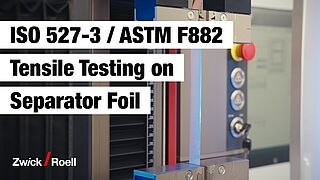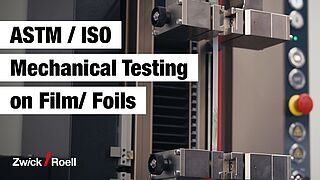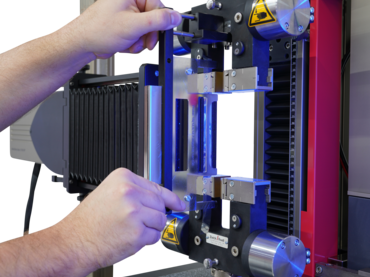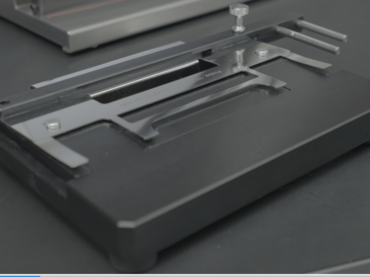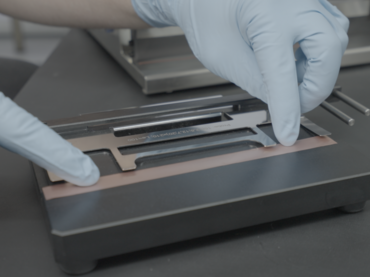ASTM D882 Film Tensile Test
ASTM D882 is a standard test method for determining the tensile properties of thin plastic films with a thickness of less than 1.0 mm (0.04 in) and is of great importance in the film packaging industry, both for quality control and research and development.
Below you will find an overview of ASTM D882 with regard to the use and significance of the standard, test specimens, test procedure and required test equipment, results and key figures. For full information on ASTM D882, it is essential to purchase the standard.
The ISO equivalent, ISO 527-3, is similar to ASTM D882 but cannot be considered technically equivalent, as the ISO allows additional specimen geometries, requires different test speeds and the use of an extensometer or gauge marks on the specimen. According to the ASTM standard, use of an extensometer is optional.
Tensile tests on plastics with a specimen thickness greater than 1.0 mm (0.04 in) are performed in accordance with test method ASTM D638.
Objective and characteristic values Tensile test on separator films Specimens Running a test & test equipment Automated film testing
ASTM D882 objective and determined characteristic values
Thin plastic films play a particularly important role in the packaging industry for the protection of food and everyday consumer goods. Plastic manufacturers and packaging companies use the mechanical properties determined to assess the performance of their plastic films, for quality control of the film batches produced and in the development of continuously improved materials.
ASTM D882 covers the determination of the following characteristic values:
- Tensile strength: is calculated by dividing the maximum force by the original cross-section of the specimen. The result is expressed in force per unit area (megapascals). Tensile strength at break: is calculated in the same way as the tensile strength, but using the force at break instead of the maximum force
- Point of break: stress and strain at the moment of specimen break
- Yield point: stress and strain at the curve plot point at which the gradient is zero
- Modulus of elasticity: is an index for the stiffness of thin plastic films
- Tensile energy to break
- Breaking factor: is calculated by dividing the maximum force by the original width of the specimen (kN/m)
Tensile tests on separator film in battery testing
Separator film in a lithium-ion battery separates the anode and cathode from each other to prevent electrical short circuits. At the same time, the separator allows the flow of ionized charge carriers that are needed to close the circuit in an electrochemical cell.
In addition to ceramic separators and glass fiber nonwovens, polymer membranes are primarily used. Reliable determination of the tensile strength and strain at break provides information about the integrity of the separator film under operational mechanical stress.
While thicker separator film efficiently and safely prevents contact between the anode and cathode, thinner film makes it possible to reduce the weight of the battery and improve the energy density.
In terms of testing, the main requirements for separators are covered by tensile tests according to ISO 527-3 and ASTM D882 as well as puncture tests according to EN 14477, ASTM D5748 and ASTM F1306. These tests are also carried out in an electrolyte-wetted state in order to achieve realistic mechanical characteristics.
Active involvement in the further development of these standards, especially for battery materials, ensures that ZwickRoell test methods will continue to meet all future requirements.
ASTM D882 specimen
Films and sheets with a thickness (specimen thickness) of up to 1 mm are tested in accordance with ASTM D882 using strip specimens with a total length of at least 50 mm (2 in.) longer than the grip-to-grip separation. The specimen width b should be between 5 mm and 25.4 mm.
- For QA applications, the standard specimen in accordance with ASTM D882 has a grip-to-grip separation of L = 100 mm (4 in.) with an overall length of ≥150 mm
- For modulus determination, ASTM D882 recommends a grip-to-grip separation L = 250 mm (10 in.) with an overall length of ≥300 mm in order to minimize effects on the test results due to the specimen slipping out of the specimen holder.
ISO 527-3 also recommends the use of strip specimens, but specifies other specimen geometries and also allows other specimen types in the form of shoulder specimens.
The strip specimens according to ASTM D882 and ISO 527-3 can be produced easily with a film cutter. Specimen preparation must be carried out with particular care. Notches and cracks must be avoided at all costs, as this can lead to premature breakage of the specimen.
Running a test and test equipment
- When carrying out the film tensile test in accordance with ASTM D882, it is essential to ensure that the specimen is vertically aligned when clamping it. The specimen grips used must be able to hold the thin plastic film specimen evenly and securely during the tensile test without causing the specimen to slip or crush/break in the specimen grips.
- Properties of certain films can change with the in-plane direction (anisotropy), so specimens of both orientations should be tested.
- The test speed can be set in the testXpert testing software depending on the expected elongation at break of the specimen.
- During the centering of a less rigid film specimen or due to clamping pressure, the specimen can already be pre-tensioned before the test begins. This is necessary to avoid a curve foot in the stress-strain diagram. However, it should not exceed a defined voltage value when measuring the tensile modulus and the voltage values. A standard-compliant preload can be defined using the testXpert testing software, thus ensuring accurate and repeatable test results.
ASTM D882 testing machine
The tensile test on thin plastic films according to ASTM D882 is usually carried out on a zwickiLine 500 N single-column universal testing machine due to the low breaking forces. For specimens with a grip-to-grip separation L = 250 mm, which are favored for modulus determination, it may be necessary to use an extra high single-column load frame from the zwickiLine series to perform the test until breakage due to a high elongation at break.
Strain measurement / extensometer
- To determine the strain measurement, ASTM D882 recommends crosshead displacement measurement, i.e. recording and calculating the strain via the change in specimen grip distance during the test. An extensometer such as for ISO 527-3 is not required.
- An extensometer, which measures the strain between two points on the specimen, can be used as an option. Due to the sensitivity of the film specimens, care must be taken to ensure that the load on the contact points of the specimen by the extensometer is as low as possible. We therefore recommend the use of a non-contact video extensometer (videoXtens 2-150 HP or videoXtens 1-270 P, depending on the expected strain of the specimen).
ASTM D882 - specimen grips and jaw inserts
- The vertical alignment of the specimen and a gentle yet secure clamping technique are the challenge in plastic film testing and therefore crucial for accurate determination of the tensile properties in accordance with ASTM D882. The use of pneumatic grips with Fmax 1kN and aluminum/Vulkollan jaw inserts can be particularly advantageous for films that tend to constrict, as the clamping pressure is maintained during the test.
- The insertion aid for safe and fast insertion of thin plastic films into the specimen grips ensures vertical alignment of the specimen by reducing user error and operator influence when positioning the specimen. This ensures reliable test results and increases specimen throughput. The insertion aid is available for different specimen widths and lengths in accordance with ASTM D882.

Film tensile test to ASTM D882 with our testXpert testing software
Our testXpert testing software makes carrying out the film tensile test in accordance with ASTM D882 simple and reliable:
- Guaranteed standard-compliant and operator-independent: The test program is parameterized and validated centrally at our company in accordance with standards. All system configuration parameters are loaded automatically. Compliance with the extensive requirements of the standards is not dependent on individual persons.
- Uncompromisingly adapted to the standard: The tool distances are set absolutely and tamper-proof in the test program. This allows the correct grip-to-grip separation for the specimen, e.g. 100 mm, to be recognized and tracked at a glance.
- Time saving, as every test counts: The results can also be recalculated after the test if, for example, the specimen geometry is corrected.
Automated film tensile test to ASTM D882 with roboTest F
Quality assurance is essential in the production of plastic films. In addition, a growth market such as the electric vehicle industry requires automated solutions to increase throughput and efficiency in film testing due to increasing test volumes. ZwickRoell has developed the roboTest F robotic testing system for this purpose.
- The testing system includes an AllroundLine testing machine with an extended test area.
- Specimens for tensile testing are fed into the system by a specimen magazine that holds up to 200 specimens.
- The magazine consists of a base and a revolving chain with grippers for gripping the specimen.
- These grippers vary depending on the specimen type and shape. This means that films of various dimensions can be tested using the same system.
In addition to the medium-term reduction in testing costs, the advantage of this system lies in error-free testing. Test results are highly reproducible due to the elimination of operator influence.
More about the roboTest F ROI calculator Request a consultation
Downloads for film tensile test to ASTM D882
- Industry Brochure: Plastics & Rubber PDF 9 MB
- Product Information: zwickiLine Testing Machine up to Fmax 5 kN PDF 820 KB
- Product Information: Pneumatic Grips Fmax 1 kN PDF 3 MB
- Product Information: Insertion Aid for Thin Flexible Foils/Films PDF 714 KB
- Product information: videoXtens 2-150 HP PDF 1 MB
- Product Information: videoXtens 1-270 P PDF 1 MB
- Product Information: roboTest F Automation for Non-Rigid Specimens PDF 98 KB
